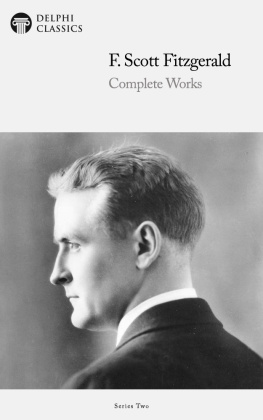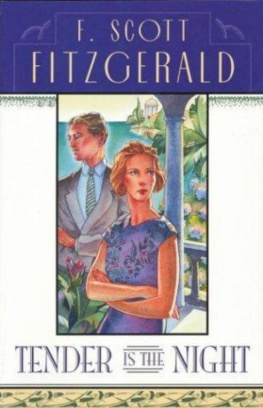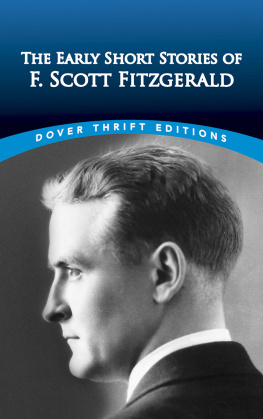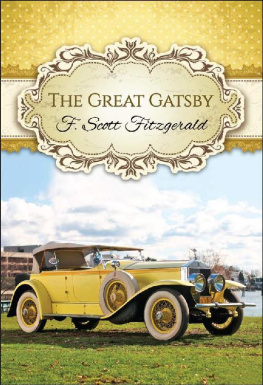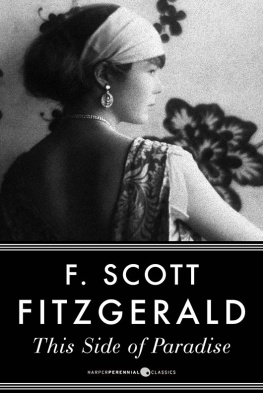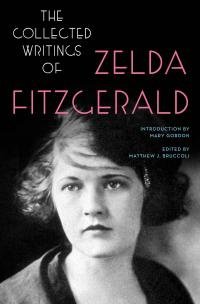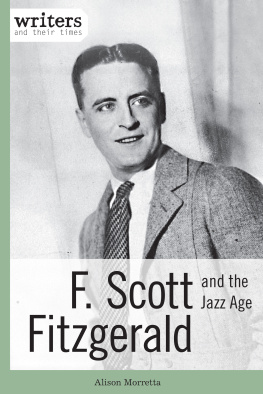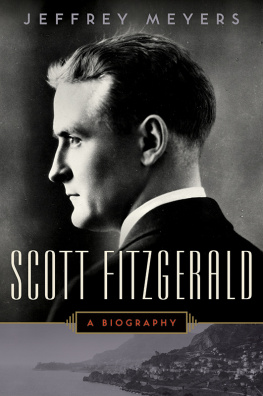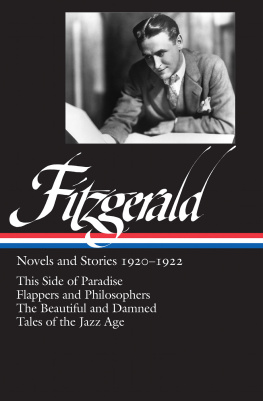BY F. SCOTT FITZGERALD
NOVELS
THE LAST TYCOON ( Unfinished )
TENDER IS THE NIGHT
THE GREAT GATSBY
THE BEAUTIFUL AND DAMNED
THIS SIDE OF PARADISE
STORIES
BITS OF PARADISE
uncollected stories by F. Scott and Zelda Fitzgerald
THE BASIL AND JOSEPHINE STORIES
edited and with an introduction by Jackson R. Bryer and John Kuehl
THE PAT HOBBY STORIES
edited and with an introduction by Arnold Gingrich
TAPS AT REVEILLE
SIX TALES OF THE JAZZ AGE AND OTHER STORIES
with an introduction by Frances Fitzgerald Smith
FLAPPERS AND PHILOSOPHERS
with an introduction by Arthur Mizener
THE STORIES OF F. SCOTT FITZGERALD
a selection of 28 stories, with an introduction by Malcolm Cowley
BABYLON REVISITED AND OTHER STORIES
THE SHORT STORIES OF F. SCOTT FITZGERALD
edited and with a preface by Matthew J. Bruccoli
ID DIE FOR YOU AND OTHER LOST STORIES
edited and with an introduction by Anne Margaret Daniel
STORIES AND ESSAYS
THE CRACK-UP
edited by Edmund Wilson
AFTERNOON OF AN AUTHOR
with an introduction and notes by Arthur Mizener
THE FITZGERALD READER
with an introduction by Arthur Mizener
LETTERS
THE LETTERS OF F. SCOTT FITZGERALD
with an introduction by Andrew Turnbull
CORRESPONDENCE OF F. SCOTT FITZGERALD
edited by Matthew J. Bruccoli and Margaret M. Duggan
F. SCOTT FITZGERALD: A LIFE IN LETTERS
edited by Matthew J. Bruccoli
LETTERS TO HIS DAUGHTER
edited by Andrew Turnbull and with an introduction by Frances Fitzgerald Lanahan
AS EVER, SCOTT FITZ: LETTERS BETWEEN F. SCOTT FITZGERALD
AND HIS LITERARY AGENT, HAROLD OBER
edited by Matthew J. Bruccoli and Jennifer McCabe Atkinson
DEAR SCOTT/DEAR MAX: THE FITZGERALD-PERKINS CORRESPONDENCE
edited by John Kuehl and Jackson Bryer
DEAR SCOTT, DEAREST ZELDA
edited by Jackson R. Bryer and Cathy W. Barks
POEMS
POEMS, 19111940
with an introduction by James Dickey
AND A COMEDY
THE VEGETABLE
with an introduction by Charles Scribner III

Scribner
An Imprint of Simon & Schuster, Inc.
1230 Avenue of the Americas
New York, NY 10020
www.SimonandSchuster.com
Copyright 2002 by Jackson R. Bryer and Cathy W. Barks
Introduction copyright 2002 by Eleanor Lanahan
Heretofore unpublished letters copyright Eleanor Lanahan, Thomas P. Roche, and Christopher T. ByrneTrustees under agreement dated July 3, 1975, by Frances Scott Fitzgerald Smith.
Originally published in Great Britain in 2002 by Bloomsbury Publishing UK
All rights reserved, including the right to reproduce this book or portions thereof in any form whatsoever. For information, address Scribner Subsidiary Rights Department, 1230 Avenue of the Americas, New York, NY 10020.
First Scribner trade paperback edition July 2019
SCRIBNER and design are registered trademarks of The Gale Group, Inc., used under license by Simon & Schuster, Inc., the publisher of this work.
Cover design by Math Monahan
Cover photograph: Everett Collection Inc./Alamy Stock Photo
Decorative elements on spine: L_Kramer/iStock/Getty Images Plus
For information about special discounts for bulk purchases, please contact Simon & Schuster Special Sales at 1-866-506-1949 or .
The Simon & Schuster Speakers Bureau can bring authors to your live event. For more information or to book an event, contact the Simon & Schuster Speakers Bureau at 1-866-248-3049 or visit our website at www.simonspeakers.com.
Library of Congress Cataloging-in-Publication Data is available.
Title page photograph: Embarking on The Cruise of the Rolling Junk.
Courtesy of Princeton University Library
ISBN 978-1-9821-1712-2
ISBN 978-1-9821-1713-9 (ebook)
To Mary and David
Happily, happily foreverafterwards the best we could.
ACKNOWLEDGMENTS

I n preparing this book, we received assistance from a number of people. Ronald Goldfarb and Kristen Auclair found us a publisher. At St. Martins Press, Diane Higgins, our editor, was a consistent voice of support and encouragement, along with her assistant, Nichole Argyres. Carol Edwards not only copyedited our manuscript expertly; she improved it significantly. Mary C. Hartig, Marc Singer, Sarah Barks, and David Bryan Barks helped prepare the text. Eleanor Lanahan, Wendy Schmalz, AnnaLee Pauls, Don C. Skemer, Ruth Prigozy, Judith Baughman, Tom Adams, David Bryan Barks, Rosemary Mizener Colt, Mary Anne Neeley, and Lisa Hartjens assisted us in securing photographs.
LIST OF ILLUSTRATIONS

Illustrations in Text
PREFACE

T he most important relationship that either F. Scott or Zelda Sayre Fitzgerald had was that with each other; it was the catalyst for and foremost theme of much of their fiction. The letters they exchanged tell the story of this central relationship in their own words; those that have been previously published in editions of Scotts correspondence and in Zeldas Collected Writings have never before appeared together in one volume. In addition, there are many unpublished letters in the Princeton University library, and these deserve to be part of the record, as well. The Fitzgeralds courtship and marriage has become a compelling and enduring part of our literary history. The new letters, placed chronologically with those collected previously, allow us to view their relationship in a more evenhanded manner than heretofore has been possible.
The most detailed and accurate account of the Fitzgeralds relationship is still Nancy Milfords best-selling Zelda: A Biography (1970). Milford was the first not only to explore the many letters Zelda wrote to Scott but also to attempt putting them in some kind of order. In the prologue to Zelda, Milford recalls how she and her husband read the letters aloud to each other as if they had just arrived, not knowing from what terrain of their lives they had been written or what the next one would say. They were hopelessly mixed up and undated, without, in most cases, envelopes to give them dates.... I had somewhat innocently... entered into something I neither could nor would put down for six years... (xiii). Much of Milfords account is based on these letters, from which she quotes extensively; yet only a sampling of them could appear in her biography, and even then only in a highly truncated form. Now, for the first time, we can read those intriguing letters from Zelda to Scott for ourselves.
Over thirty years have passed since the Milford biography, and, as a society, we have learned much (though still not enough) about the nature of mental illness (from which Zelda suffered) and alcoholism (from which Scott suffered). Yet this knowledge has not been reflected in what has been written about the Fitzgeralds. The tendency has been to sensationalize their lives and illnesses.
Scott and Zeldas lives were indisputably dramatic and tragic, and therefore all too easy to distort. Perhaps the most sensational myth of all is the persistent claim that Scott, jealous of his wifes creativity, suppressed her talents and drove her mad. Koula Svokos Hartnetts view of the Fitzgeralds marriage, in Zelda Fitzgerald and the Failure of the American Dream for Women (1991), regrettably is all too representative: As his appendage, [Zelda] was to become the victim of [Scotts] self-destructive urge. In denying her the right to be her own person... , by refusing to permit her the use of her own material... , by rebuking her for attempting to create a life of her ownhe gradually causes her to emotionally wither and die (187). Such an assertion defies common sense as well as even the most fundamental understanding of mental illness; yet it has gained some general acceptance. For further evidence that this view persists, one has only to look at the most recent biography of the Fitzgeralds, published in 2001 and claiming to be definitive, in which Kendall Taylor asserts:
Next page

